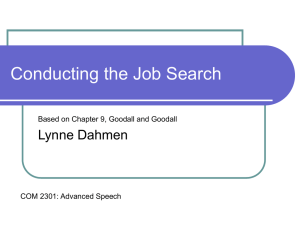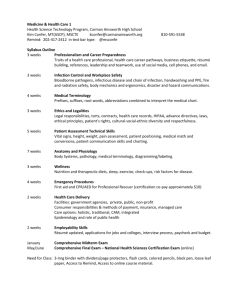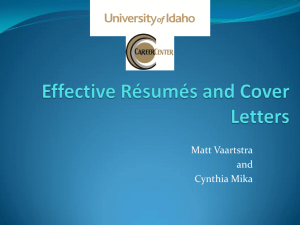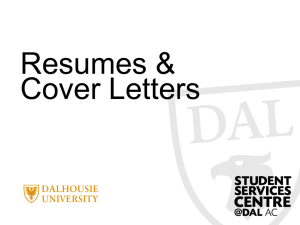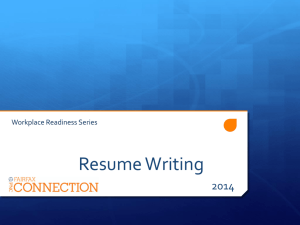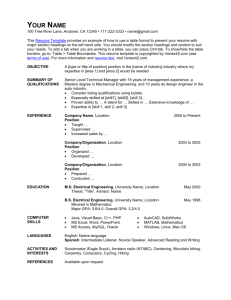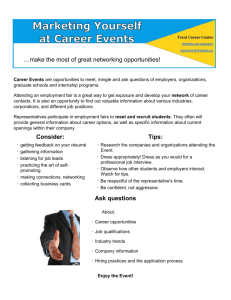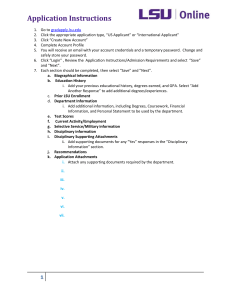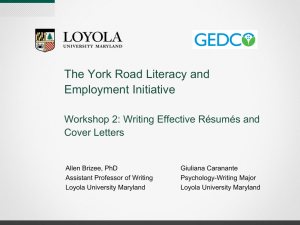Biggest Mistakes - Smith Scholarship Foundation
advertisement
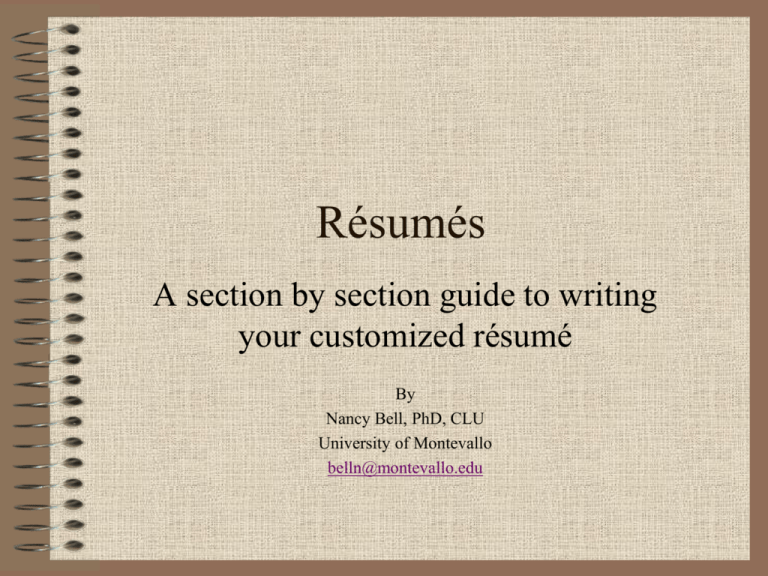
Résumés A section by section guide to writing your customized résumé By Nancy Bell, PhD, CLU University of Montevallo belln@montevallo.edu What is a Résumé? • An advertisement that discloses your accomplishments and qualifications to a potential employer • A promotional brochure about you • An example of your organizational and communication skills What is the Purpose of a Résumé? • Your resume does not get you a job. Your resume gets you an interview. Your resume must: – – – – – Arouse the curiosity of the reader Grab attention Sparkle with interest Differentiate you from the competition Make you stand out from the rest What to Put on a Résumé • It will vary depending on the job you’re applying for • We will begin with a worksheet Worksheet (See Chapter 2: Kenkel’s Extreme Résumé Makeover) • Even if you already have a resume, start over with this exercise • Put everything on the worksheet • Skip sections if they don’t pertain to you • Brainstorm at this point – do not filter • Ask a relative or friend to help you get more results Worksheet • Keep the worksheet available – Excellent tool • Have dates and employers readily available when filling out applications • Will help you prepare for employment interviews • Tweak your resume to fit each position Résumé Rules • There are few rules that cannot be broken, with good cause • Do not hold back. This is not the time to be modest • Never tell a lie (never break this rule) Tips for Writing Résumés • Résumés should be concise • Résumés should not be detailed. It is not necessary to list every job - only relevant work experience • Present information in list format not in paragraphs • Do not use declarative sentences (“I developed the…” or “I managed…”) • Use action verbs!! (Developed or Managed) (See Appendix A: Kenkel’s Extreme Résumé Makeover) Tips for Writing Résumés • Avoid passive constructions (“was responsible for managing” – again “Managed”) • Describe past accomplishments so that they can be measured objectively (“saved the company $3500 for the fiscal year”) • Check your resume for proper grammar and correct spelling Tips for Writing Résumés • Allow for room between the different sections of the resume • Resumes should be printed on high quality paper stock with a matching envelope • Use simple, professional looking fonts • Use techniques for emphasis (bolding, bullets, capital letters). Avoid underlining. • Customize your resume to a specific position. (include only experience that is relevant to the job) Tips for Writing Résumés • Eliminate unnecessary details – – – – – – – age height weight marital status disabilities social security number religion Tips for Writing Résumés • Do not include a grade point average unless it is very good • Do not include a picture • List hobbies and interests only if they are relevant to the position you are seeking • Arrange information on the resume so that the most current, most important, most relevant information is presented first Tips for Writing Résumés • Do not include details that might minimize your experience (part time, seasonal, temporary) • You may omit the phrase “References available upon request” if you need more room to describe work experience or education • Avoid the “objective statement”. It can be articulated in your cover letter. If you do use an objective statement be specific. “Seeking a rewarding position” is too vague. Sections on Your Résumé • Typical Sections/Headings – – – – – Name and contact information Objective or Qualifications Summary (Profile) Education and Training Technical Skills Professional Experience Sections on Your Résumé • Optional Sections/Headings – – – – – – – – Honors and awards Certifications/license Language skills Professional affiliations Community affiliations Military Hobbies and interests Addendum Name • Name – Typically center at the top of the page and all contact information centered directly below it • Alternative: create a professional looking personal letterhead with your name and contact information, and use the same letterhead for your cover letter – Can be the name you go by, but avoid nicknames like Kitty, Buddy or Junior – If you hold a relevant advance degree or designation (MBA, JD, CPA) it can be directly up by your name • Examples: – Nancy Sutton Bell, PhD, CLU – Marvin D. Narz, JD, CPA, LLM Contact Information • Street address – may only put city and state for security purposes, such as if you are posting on the web • Email address – You must include an email address – Be sure it sounds professional • Phone numbers – List 1 or 2 to make it easy to reach you and be diligent about checking messages – Proof read for accuracy Objective • A brief (usually one-to-two line) statement of the type of position you’re looking for and/or your main qualifications. • May be sentence format or descriptive phrases with minimal punctuation Objective • Include if: • The experience listed on your résumé does not make it obvious that you are seeking a particular type of job • You are a recent graduate or anyone seeking an entry-level position where your work experience is limited and your degree or major may not directly speak to your target • You are applying a particular job opening and can tailor the objective statement to that job’s specifications • DO NOT include if: • You want to keep your options open • You are a senior-level executive or professional – Then open with an “Executive Profile” • You use a qualifications summary or profile statement that makes the objective redundant Profile Sample Capable of working independently or as part of a team Excellent written and oral communication skills Strong track record in leading organizations Experienced in customer service Well organized and responsible Great time-management skills Energetic and ambitious • Include if: – You need to fill space on your resume – You need to summarize transferrable skills gained from many positions Education and Training • List highest degree (or expected degree) first • University name, city, state – Major – and minor (if you have one) – Expected graduation date – You may include relevant information such as: • Worked 20 hours per week while attending school full-time • If a student athlete say something like: “Soccer Scholarship: trained over 20 hours per week” • Names of scholarships (or can include under “Honors and Awards”) • For additional training, such as employer-sponsored seminars, certificate programs, or seminars you attended on your own, list the exact names of who offered the courses. If you attended many summarize them: “Attended more than 20 seminars and training programs on topics including communication, conflict resolution, time management, and supervisory skills.” Technical Skills • If very relevant to the job you seek include directly after the objective or summary statements. • For MIS graduates may separate into appropriate categories such as Software, Operating Systems, Client Server Tools, etc. • Example: Platforms: Windows XP, Windows 2000, Windows NT Productivity Tools: Microsoft Word, Excel, Power, Point Professional Experience • Relevant work history • May be called: – – – – Professional Experience Work History Career Summary Employment History Professional Experience • List the company name of your most recent employer’s beginning at the left margin. • Next to employer name, list the city and state where the organization is located. • Indent over on the same line and put the inclusive years you worked for that employer. If still employed put beginning year to present, such as “2010 to present” Professional Experience • Job titles – Under employer’s name list all job titles you held while at that company. • Job content snapshot – A brief paragraph that appears immediately under your job title – Emphasize relevant responsibilities – Should convey your level and scope of responsibilities – Follow with bulleted statements that highlight your achievements. Try to quantify achievements. Professional Experience Example: Operations Manager Full responsibility for hiring, planning, scheduling, and evaluating 12 employees. • Led department from last to 1st of the 10 department • Boosted employee satisfaction rating from 75% to 95% • Reduced department budget by 30% • Continue to list relevant professional experience in reverse chronological order. Professional Affiliations • If you have more than one (otherwise under appropriate section) • List the organization & your role • Dates optional – Member since 2011 – Inclusive dates – If you list dates for one, list dates for all (be consistent) Extracurricular Activities • List if they provided relevant skills and knowledge, such as leadership experience (officer in an organization), treasurer (budgeting or accounting experience), membership or rush chair (marketing), chair of a particular event • Generally avoid controversial affiliations Honors and Awards • If you’ve received at least 2 or 3 educational, professional, community service/civic honors and awards may include a separate section – If only one list under appropriate section instead (such as education or community service) – Definitely list scholarships, honor societies, distinctions – Typically include honor, what it was awarded for, and by whom. – Dates are option, but list for all if you list for one (be consistent) • May be called: – Honors – Awards – Honors and Awards Community Affiliations • If you’ve done a good bit of community service, including volunteer or charitable work, list if it strengthens your case by showing you as well-rounded or possessing certain skills relevant to the job. • List organizations and your role – especially any leadership roles (dates are optional) Language Skills • May list under qualifications summary instead. • Give not only the language but some idea of level of proficiency. • Examples Fluent in Spanish Basic working knowledge of French Conversational Mandarin Certifications/Licenses • Include section if you hold licenses or certifications relevant to your target job • Very significant ones go by your name – Example: Mary Smith, CPA • If only one may list under qualifications summary or job you held when achieved Military • If a significant part of your overall professional history you may list under professional experience section • List branch of service, location(s), rank, and positions held (job description(s) if they demonstrate relevant skills and knowledge Hobbies and Interests • Controversial whether to include – May help as a conversation starter and/or showing you are well rounded – Golf is frequently relevant to positions, but reading and walking typically aren’t. Addendum • Not typically included • May cover details left out of a one or two page résumé • May give relevant additional information on – project-based work – Consulting assignments • On a separate page put – Name and contact information – Center heading “Résumé Addendum” – Put appropriate headers Alternative Headings • If the headings discussed so far don’t emphasize your strengths simply create your own headings to match the content of your resume and the job ad. You can do this by modifying, for example, Experience or Activities with descriptive adjectives that describe your skills more accurately (like Supervisory Experience, Leadership Activities, etc.). Alternative Headings •Or you may use altogether different headings. Here are some others to consider: – – – – – – – publications presentations in-house seminars internships relevant coursework continuing education advanced career training – specialization – special projects – career-related skills – familiar computer applications – accomplishments – skills summary – volunteer work – memberships Putting It All Together • Create a visual hierarchy – Major headings – Subheadings (and sub-subheadings, if used) – Text/body sections (and subsections, if used) • Use a consistent format & style • Use résumé paper Putting It All Together • Use the whole page. Biggest Mistakes • Too long – Most résumés are read in about 10 to 30 seconds – Needs to be a length that can be quickly skimmed to pick up on key points and highlights what you’ve done and what you have to offer Biggest Mistakes • Laundry list of duties – Focus should be on your achievements – how you made a difference and brought about positive results – Examples: • Generated new accounts for a 15% sales increase • Hired and trained more than 20 new associates • Trained and mentored 3 new sales associates who were promoted to management positions within 18 months • Secured 3 new contracts resulting in more than $12 million in revenue Biggest Mistakes • No clear objective – Make it clear what strengths and skills you bring to the job – May use objective statement, summary of qualifications, or profile section to clarify – Omit any irrelevant information • For instance a candidate for a Bank Lending Officer position placed under education section completing a real estate preparation course leading potential bank employers wondering if they were working toward a career change. Biggest Mistakes • Not customized – Make sure that every work, every job description, every asset statement, and every educational or professional credential included on your résumé is tailored as much as possible toward your target job. • Example: Applying for Marketing Management position & have job experience as a waitress, emphasize the customer service or training aspects of the waitress position • LOOK FOR TRANSFERABLE SKILLS Biggest Mistakes • Typos and errors – Most will throw out any résumé the moment they see a typo or error – Have several other people proof read • Crowded or hard to follow visually – If it appears difficult to read, they generally won’t Biggest Mistakes • Poorly worded – Simple words and jargon are usually best – Examples on résumés: • A young paramedic who “makes life-threatening decisions on a daily basis” • A child-care worker who can “overlook up to 35 children at a time” • An enterprising young woman who is “flexible enough to perform in all manner of positions if the situation gets desperate” Remember... • Your resume does not get you a job. Your resume gets you an interview. • Your resume should be a promotional brochure about you, your qualifications, and your accomplishments • Your resume should be an example of your organizational and communication skills Best wishes!
